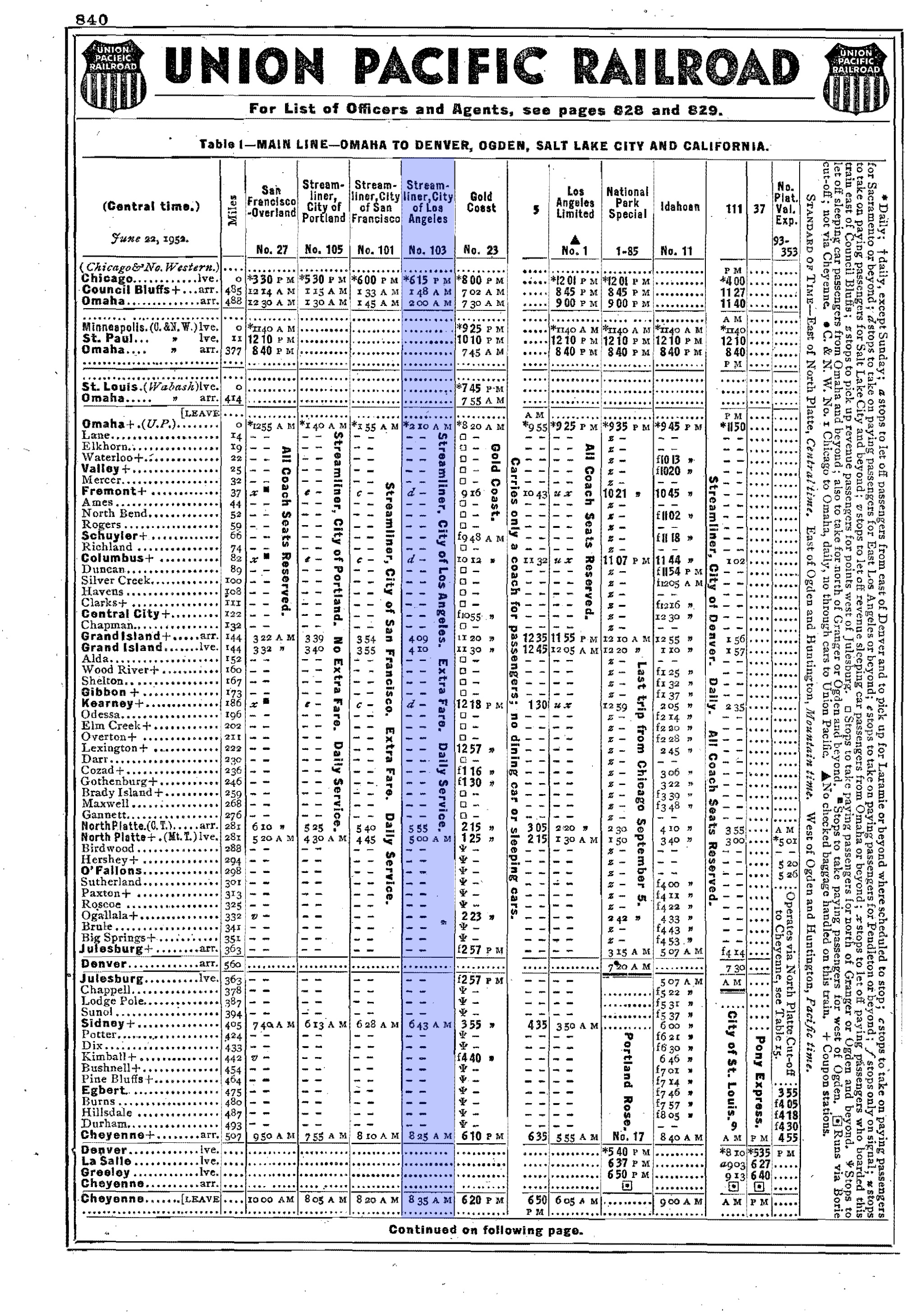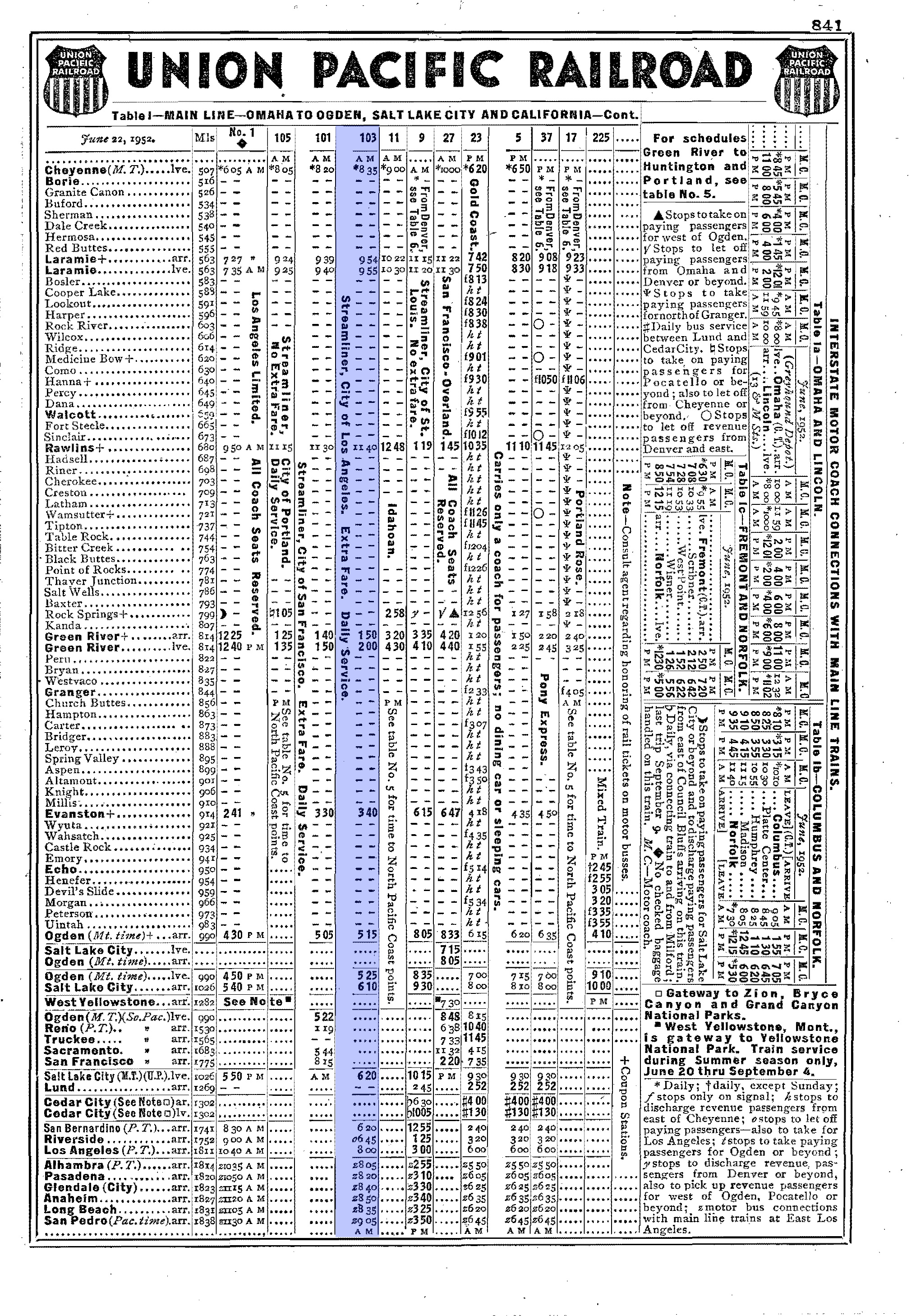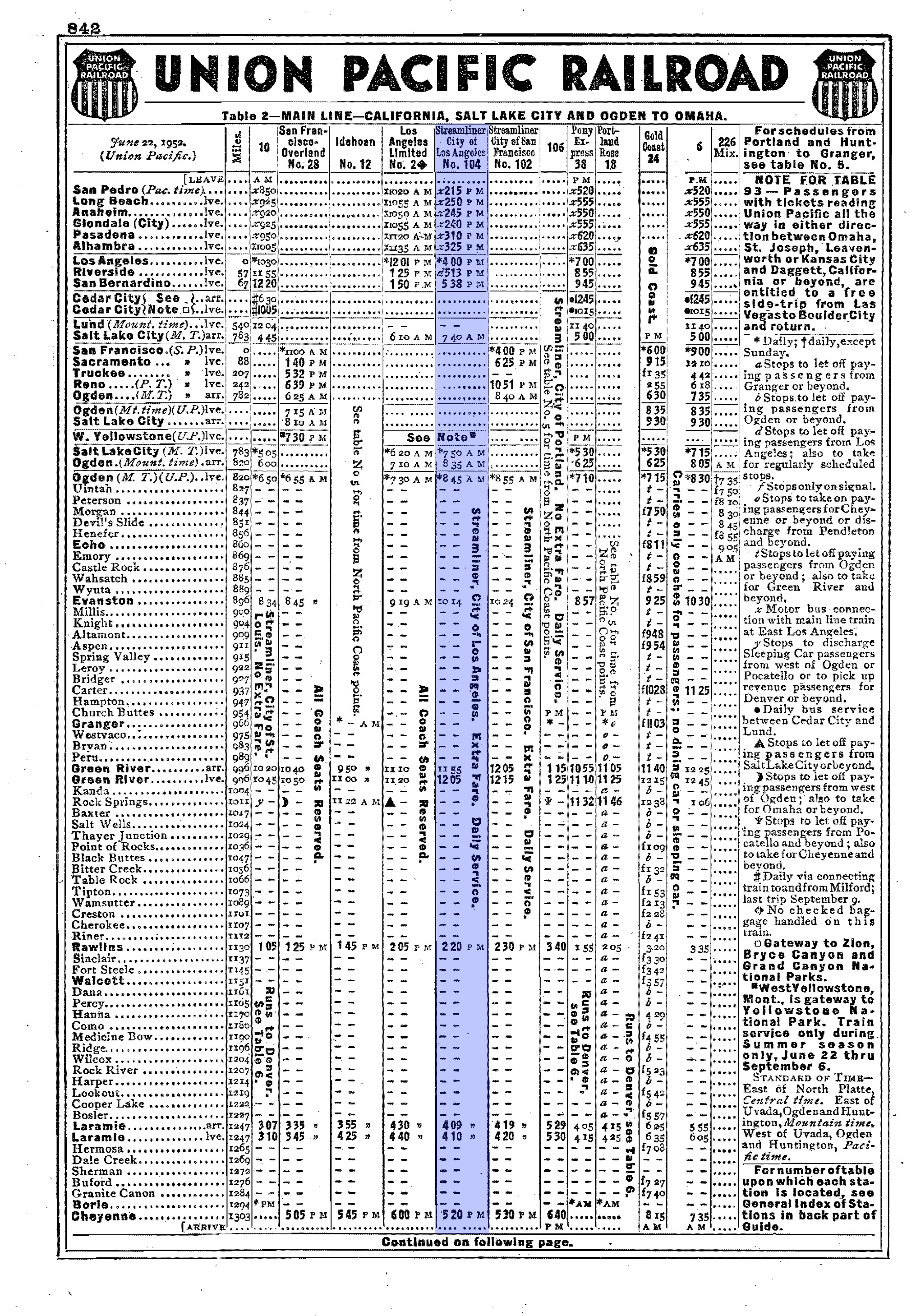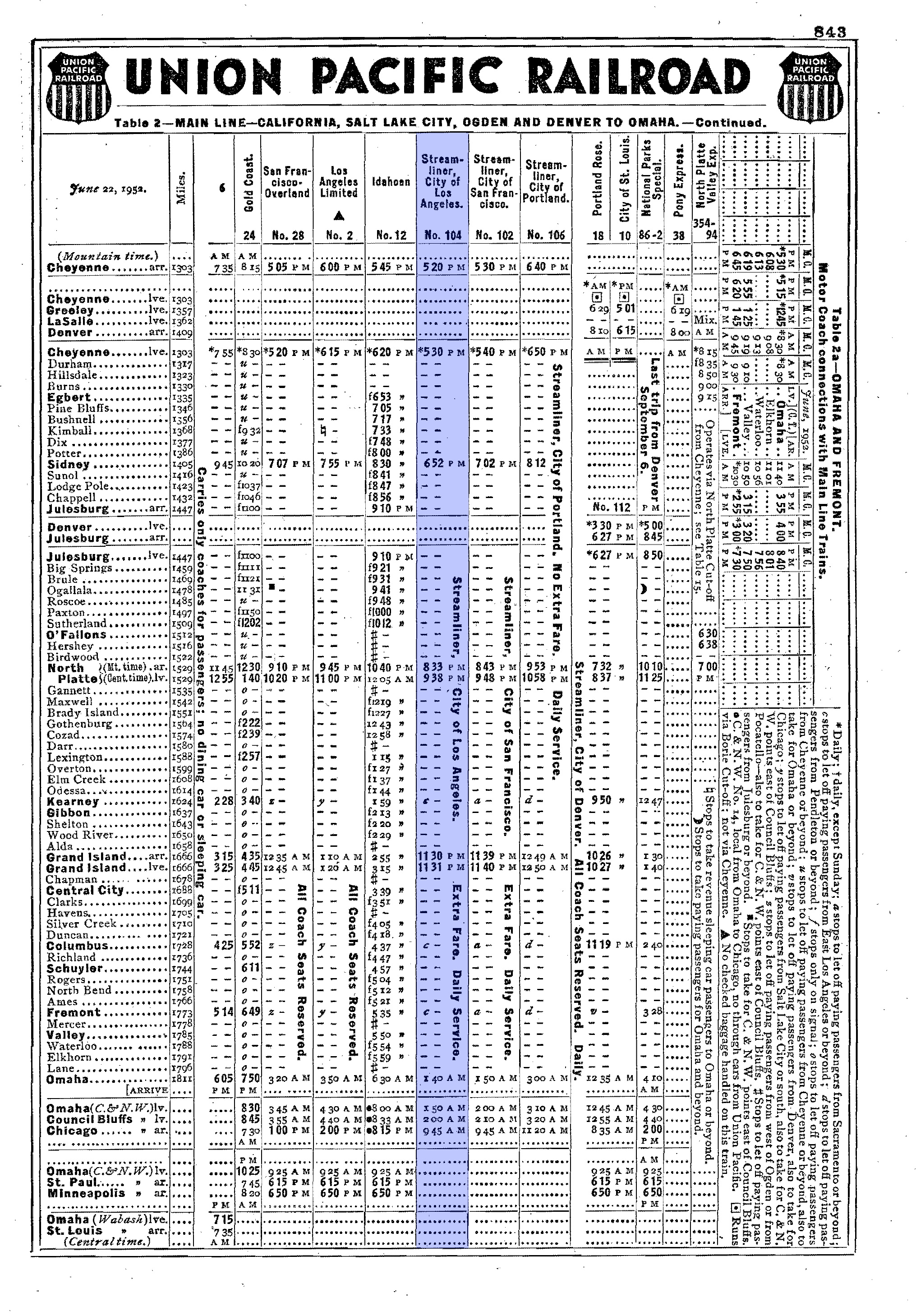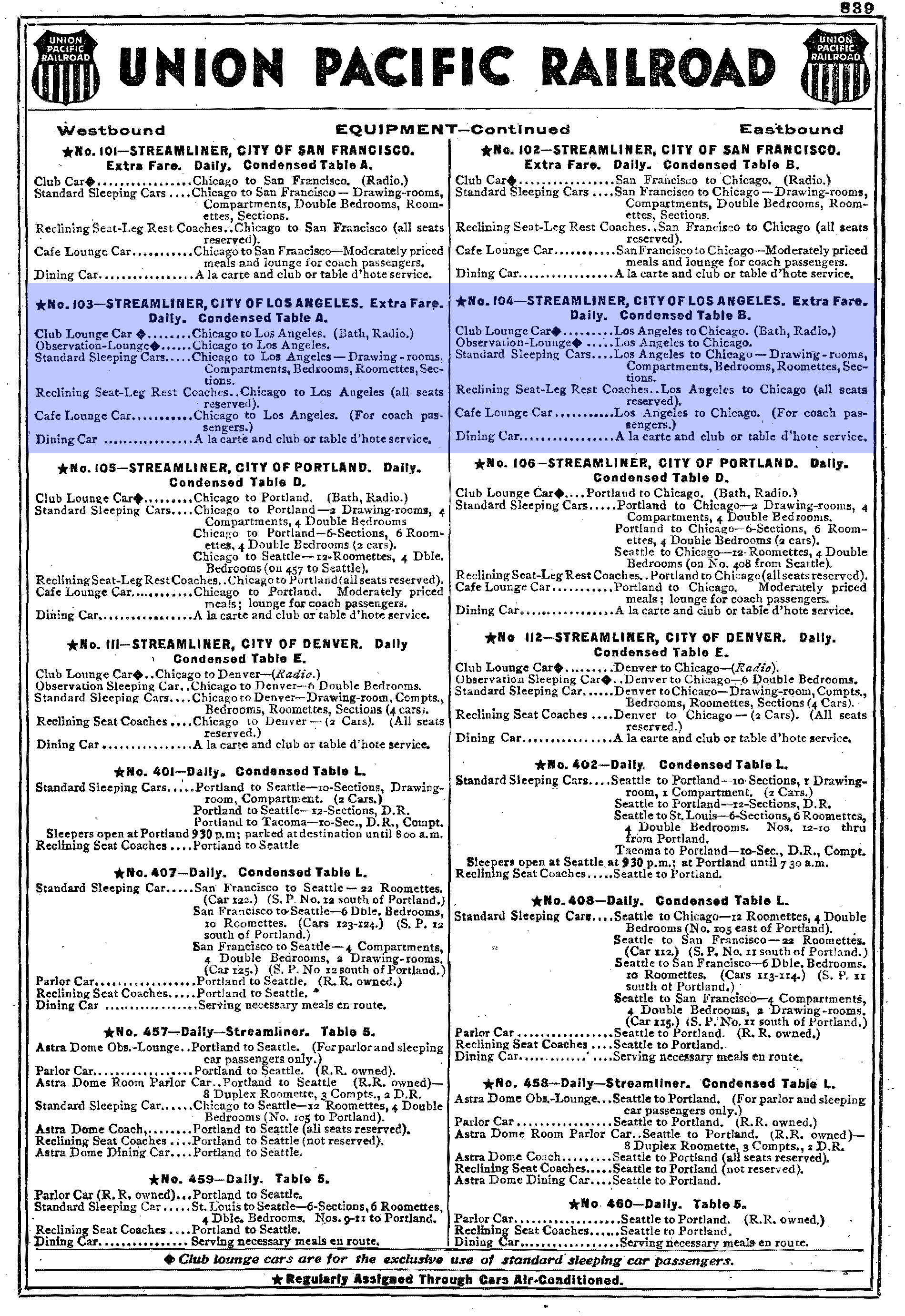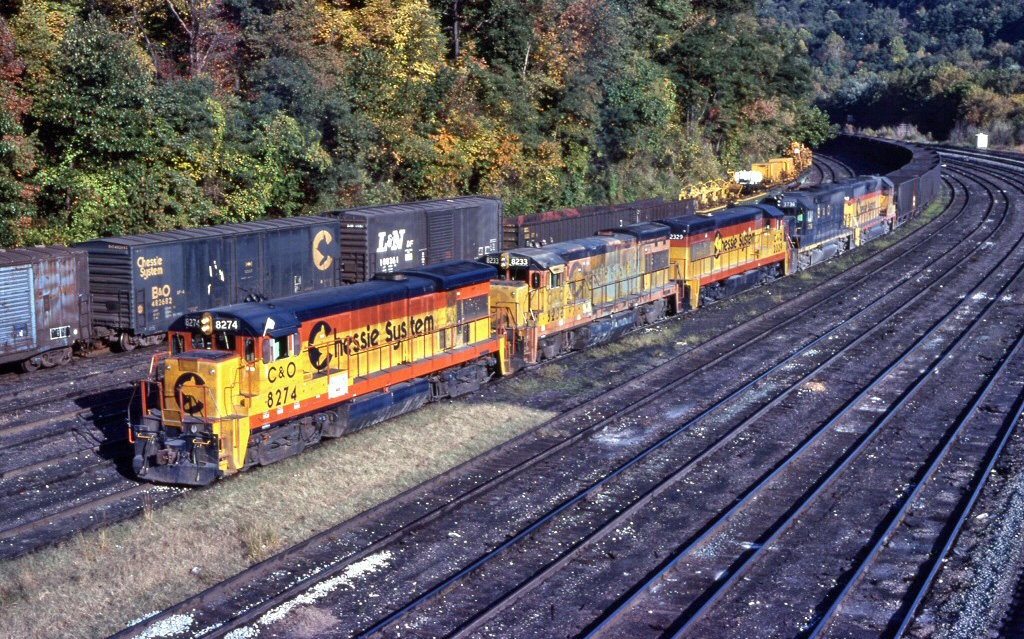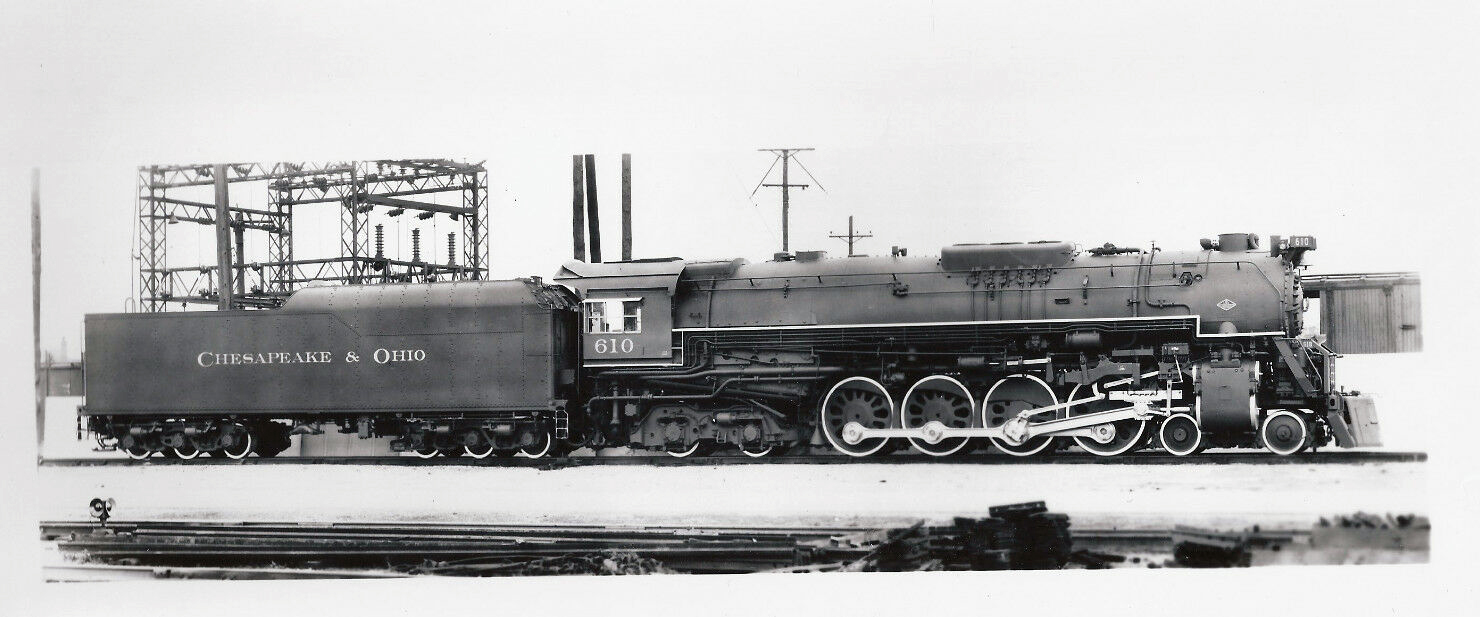"City of Los Angeles" (Train): Route, Schedule, Timetable
Last revised: February 24, 2025
By: Adam Burns
The City of Los Angeles was just one train in Union Pacific’s premier fleet. The railroad hosted an entire array of plush City trains including the City of Portland, City of Denver, City of Salina (the original M-10000), City of St. Louis, City of San Francisco, and City of Las Vegas.
The City of L.A. was one of the West's most popular streamliners, even though it required two different railroads to complete the Chicago-Los Angeles run. The train was one of the first to enter service following UP's successful M-10000 streamliner and featured incredible on-board accommodations.
As one of the only original Class I's still in operation today, Union Pacific works very hard to maintain, recognize, and honor the company's rich history. They operate historic steam locomotives (including "Big Boy" 4-8-8-4 #4014), maintain a company museum, and still sport the railroad's original Armour Yellow livery.
Today, the City fleet can still be witnessed, in a sense, via UP's official business train The consist not only includes the classic City fleet livery but is also led by original E9s.
Photos
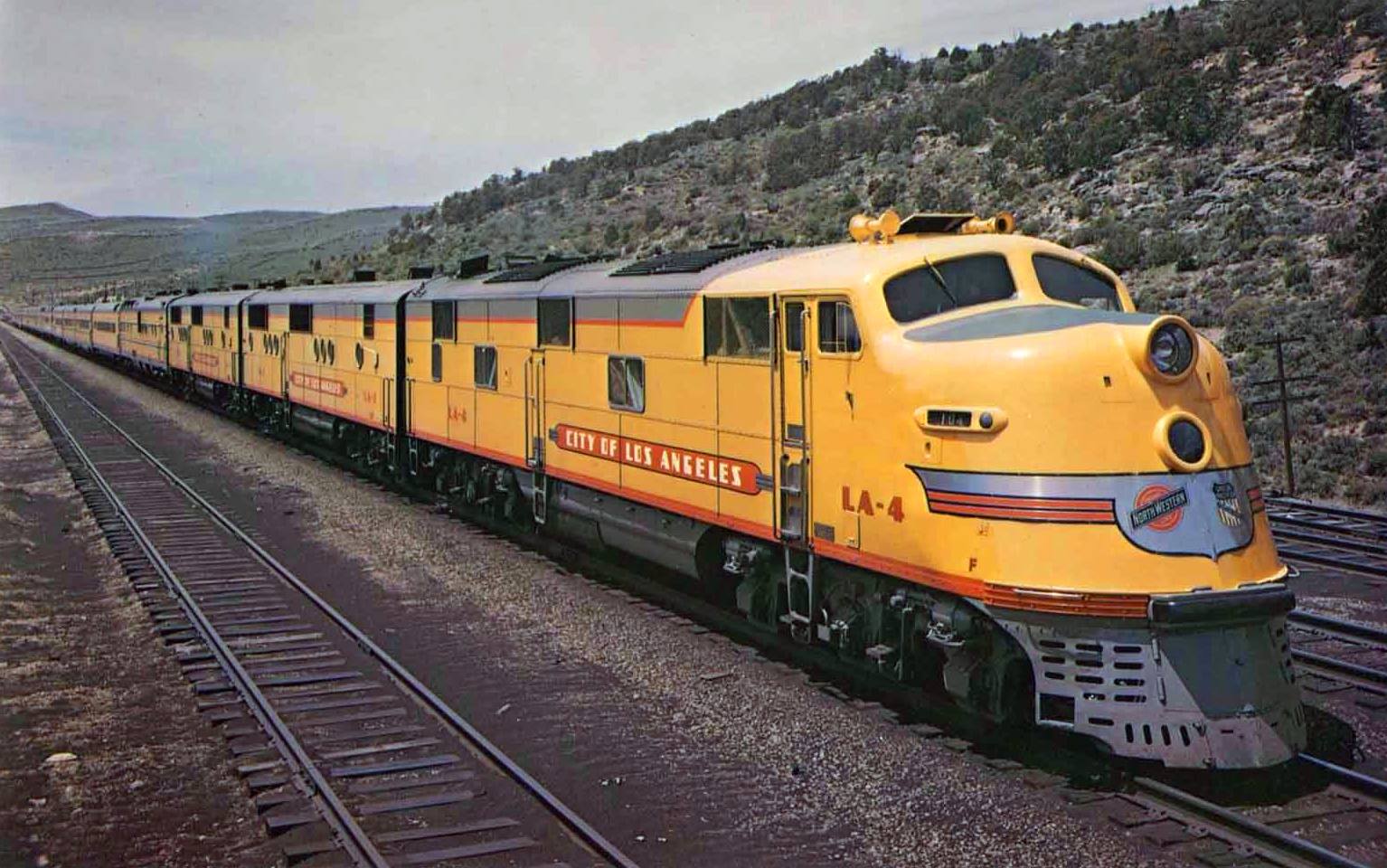 A Union Pacific publicity photo featuring the eastbound "City of Los Angeles" at Aspen, Wyoming in 1941. In the lead is E6A "LA-4" with E2B's "LA-2" and "LA-3" trailing.
A Union Pacific publicity photo featuring the eastbound "City of Los Angeles" at Aspen, Wyoming in 1941. In the lead is E6A "LA-4" with E2B's "LA-2" and "LA-3" trailing.History
Union Pacific’s City fleet is credited as the first lightweight streamliner to enter service in the U.S. In 1934 the City of Salina - originally named the M-10000 - debuted as a three-car lightweight trainset.
The railroad was so impressed with the train, and the public response, it purchased seven more sets to serve the far reaches of network throughout the west. As a result, the City fleet was born to serve Denver, San Francisco, Los Angeles, Portland, and later St. Louis.
At A Glance
40 Hours, 45 Minutes (Westbound) 40 Hours, 30 Minutes (Eastbound) |
|
103 (Westbound) 104 (Eastbound) | |
Union Passenger Terminal (Los Angeles) North Western Terminal/Union Station (Chicago) |
The City of Los Angeles entered service on May 15, 1936, originally as the semi-articulated M-10002. In the early 1940s, it was upgraded following a large order of new lightweight, streamlined equipment from Pullman-Standard and American Car & Foundry.
This particular order included some 145 cars, enough to also handle Chicago & North Western's leg of the trip between Omaha-Chicago. From this time, until UP finally discontinued its fleet following the start of Amtrak, the railroad spared no expense in ensuring its trains offered the very best in accommodations.
Timetable (1952)
The streamliner craze was just underway when America entered World War II following Japan's bombing of Pearl Harbor on December 7, 1941. In early 1942 the War Production Board placed severe restrictions on not only railroads but also the entire private sector regarding new equipment purchases.
As a result, most wishing to field their own streamliners were forced to wait. However, UP was one of the lucky few that had already placed orders beforehand and as a result was one of the few to showcase new streamlined equipment during the war.
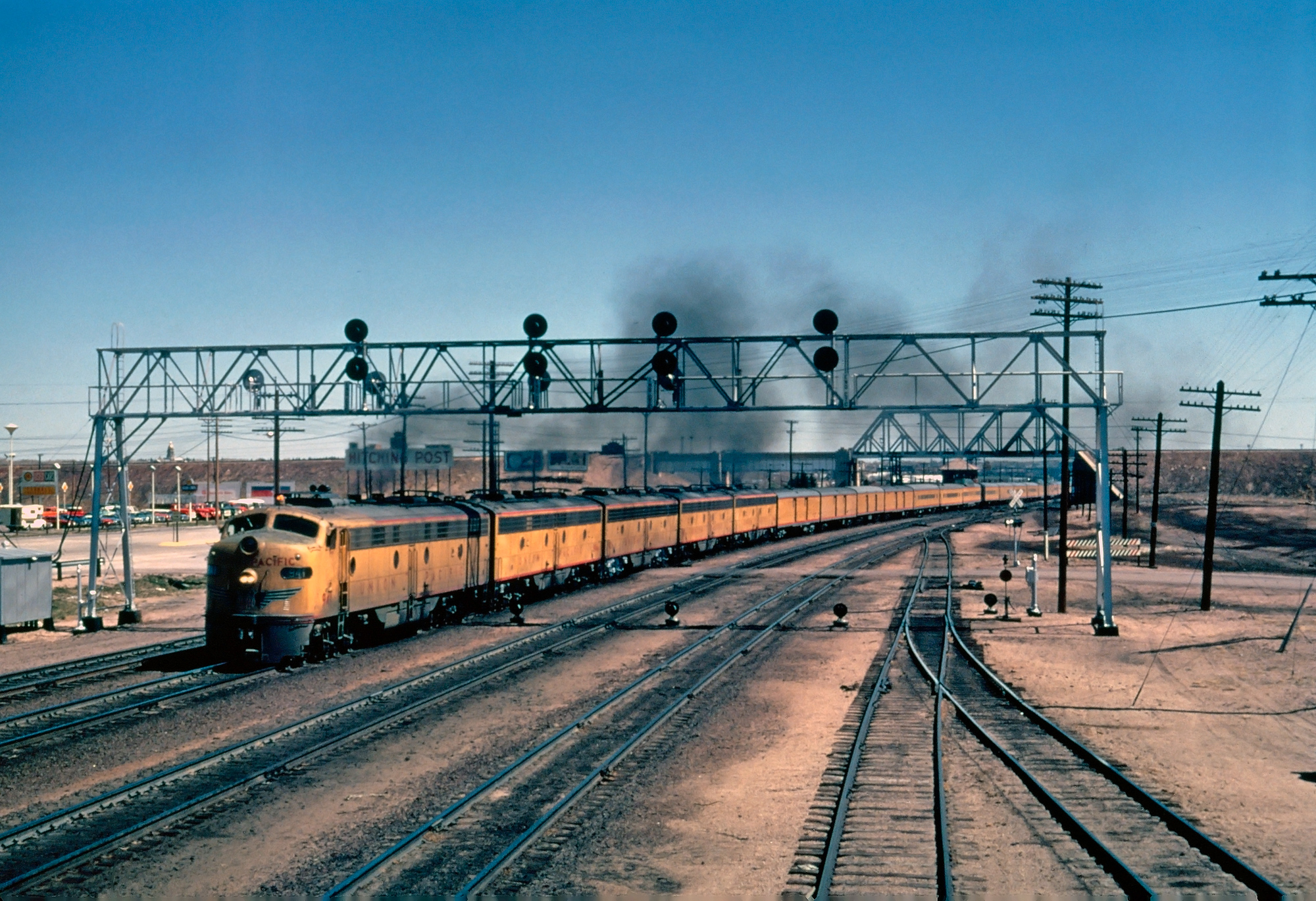 Union Pacific E8A #941 leads the combined "City Of Los Angeles"/"City Of San Francisco" westbound out of Cheyenne, Wyoming, circa 1968. This unit was later sold to the Rock Island (#661) in June, 1969. American-Rails.com collection.
Union Pacific E8A #941 leads the combined "City Of Los Angeles"/"City Of San Francisco" westbound out of Cheyenne, Wyoming, circa 1968. This unit was later sold to the Rock Island (#661) in June, 1969. American-Rails.com collection.When the City of L.A. launched it originally featured streamlined diesels manufactured from Electro-Motive. These bulbous nose locomotives were part of the manufacturer's early E2 line and the specific carbody design was interestingly never repeated on future models.
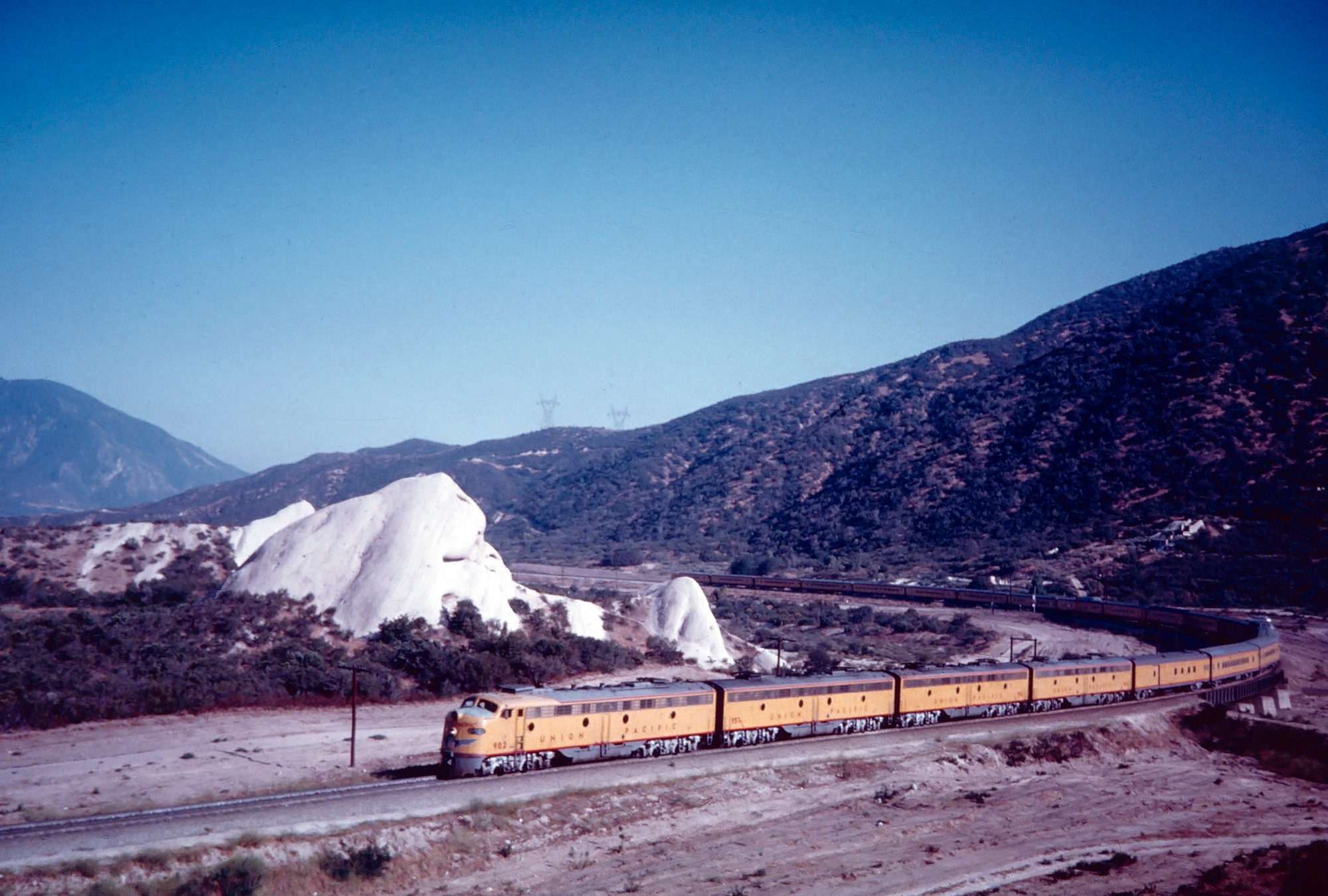 Union Pacific E9A #902 and a trio of "B" units climb Cajon Pass near Alray, California with the eastbound "City of Los Angeles" during the late 1950s. American-Rails.com collection.
Union Pacific E9A #902 and a trio of "B" units climb Cajon Pass near Alray, California with the eastbound "City of Los Angeles" during the late 1950s. American-Rails.com collection.The railroad purchased six in total with three used for the City of L.A. - E2A #LA-1 and E2Bs #LA2-LA3. The remaining three were assigened to the City of San Francisco. Just prior to the start of World War II both the City of L.A. and City of S.F. were upgraded with Electro-Motive's latest E6 models.
These particular models were the builder's first stand alone passenger locomotives. They featured the classic slant nose and sold 117 examples before the war halted production. Electro-Motive likely would have sold even more had the global conflict not taken place.
Timetable (June, 1938)
| Read Down Time/Leave (Train #103/Chicago & North Western) | Milepost | Location | Read Up Time/Arrive (Train #104/Chicago & North Western) |
|---|---|---|---|
| 6:15 PM (Dp) | 0.0 | 12:15 PM (Ar) | |
| 8:22 PM | 138 | 10:00 AM | |
| 9:38 PM | 219 | 8:43 AM | |
| 11:31 PM | 340 | 6:50 AM | |
| 1:51 AM (Ar) | 487 | 4:30 AM (Dp) | |
| Time/Leave (Train #103/Union Pacific) | Milepost | Location | Time/Arrive (Train #104/Union Pacific) |
| 2:00 AM (Dp) | 487 | 4:20 AM (Ar) | |
| 4:01 AM | 632 | 2:15 AM | |
| 5:55 AM (Ar) | 769 | 12:29 AM (Dp) | |
| 4:56 AM (Dp) | 769 | 11:28 AM (Ar) | |
| 6:40 AM | 893 | 9:44 PM | |
| 8:25 AM (Ar) | 995 | 8:18 PM (Dp) | |
| 8:35 AM (Dp) | 995 | 8:08 PM (Ar) | |
| 10:00 AM | 1051 | 6:48 PM | |
| 11:47 AM | 1168 | 4:48 PM | |
| 1:57 PM (Ar) | 1302 | 2:35 PM (Dp) | |
| 1:58 PM (Dp) | 1302 | 2:34 PM (Ar) | |
| 3:45 PM | 1402 | 12:53 PM | |
| 5:20 PM (Ar) | 1478 | 11:20 AM (Dp) | |
| 5:30 PM (Dp) | 1478 | 11:07 AM (Ar) | |
| 6:05 PM (Ar) | 1514 | 10:29 AM (Dp) | |
| 6:10 PM (Dp) | 1514 | 10:24 AM (Ar) | |
| 11:23 PM (Ar) | 1839 | 5:04 AM (Dp) | |
| 10:23 PM (Dp) | 1839 | 4:04 AM (Ar) | |
| 1:01 AM (Ar) | 1964 | 1:22 AM (Dp) | |
| 1:06 AM (Dp) | 1964 | 1:17 AM (Ar) | |
| 6:16 AM (Ar) | 2230 | 8:08 PM (Dp) | |
| 6:17 AM (Dp) | 2230 | 8:05 PM (Ar) | |
| 7:37 AM | 2292 | 6:50 PM | |
| 8:00 AM (Ar) | 2298 | 6:30 PM (Dp) |
The original City of L.A. consist featured 14 cars that included such accommodations as a club-dormitory, sleepers, coaches, an observation-lounge, and the train's marquee piece - an articulated diner-coffee shop (the diner section could seat 64). The City of L.A. was also the first streamliner to feature Pullman's new round-end observation, adding to the train's sleek look.
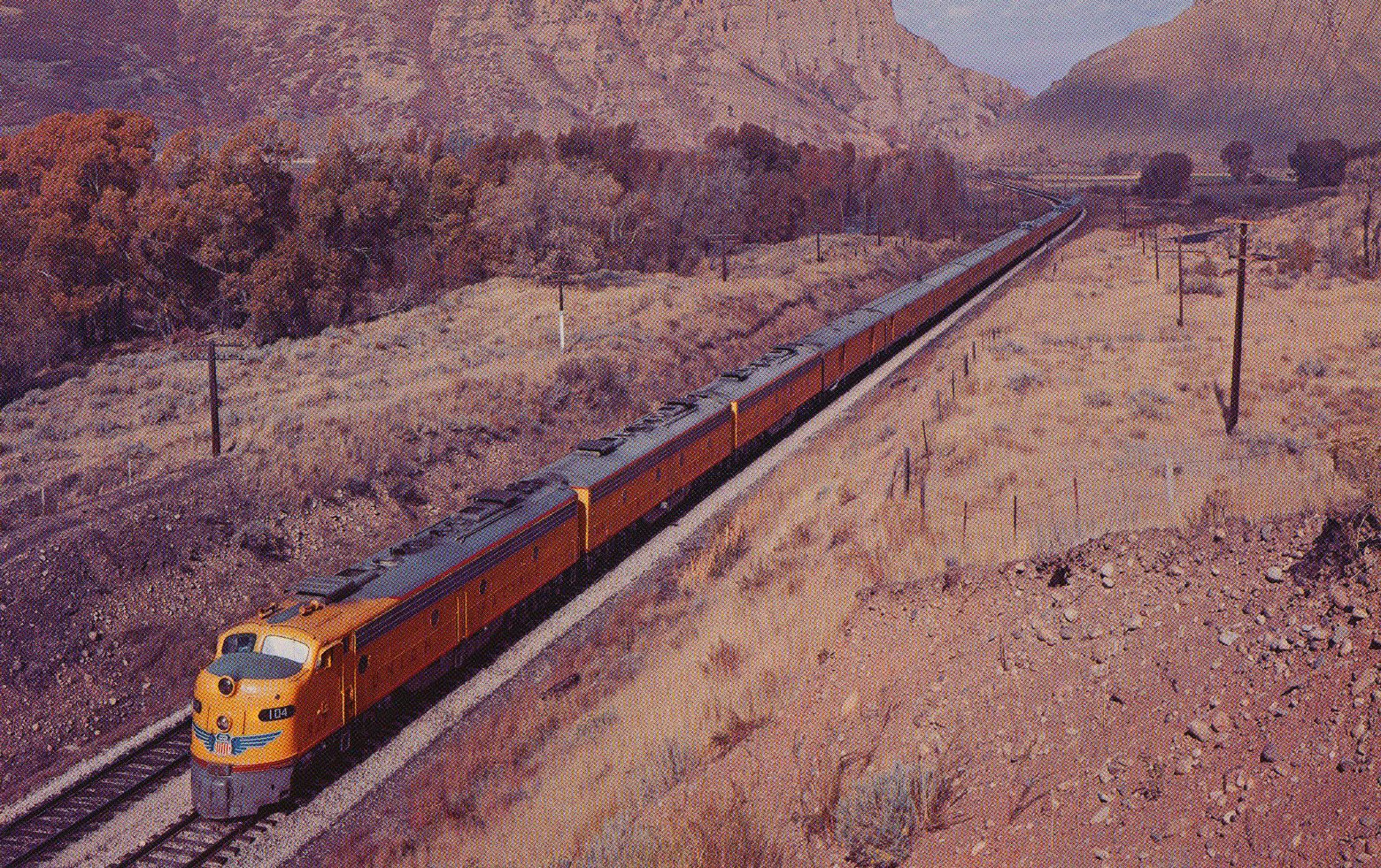 A Union Pacific publicity photo featuring train #104, the eastbound domeliner "City of Los Angeles" (Los Angeles - Chicago), near Henefer, Utah circa 1955. In the lead is E8A #927 while E9B's #969-B and #961-B trail.
A Union Pacific publicity photo featuring train #104, the eastbound domeliner "City of Los Angeles" (Los Angeles - Chicago), near Henefer, Utah circa 1955. In the lead is E8A #927 while E9B's #969-B and #961-B trail.While the train boasted a route connecting Los Angeles with the nation’s rail hub in Chicago it needed help in reaching the Windy City. While UP handled the train west of Omaha, its longtime partner Chicago & North Western carried the train - and the entire City fleet - into Chicago.
After UP felt C&NW's service was slipping it began partnering with the Milwaukee after October 30, 1955. This partnership would last until the start of Amtrak although in truth the C&NW as quite happy to discontinue handling the money-losing affair.
The two railroads continued to partner in handling the much more lucrative freight traffic between and by 1980 the Milwaukee Road would largely abandon its Iowa Division into Omaha/Council Bluffs.
Consist (1952)
To keep the City of Los Angeles' livery consistent during both the Milwaukee Road's and C&NW's tenures, the equipment featured a matching Armour Yellow and Harbor Mist Grey livery, including locomotives.
Union Pacific continued upgrading its trains throughout the late 1950s, a time when most of the industry had either stopped purchasing new equipment or even began cutting back services.
Between 1954-1958 the railroad acquired 40 new Astra Domes from American Car & Foundry and Pullman-Standard. They came in a variety of configurations - including the only diner domes ever built - and were a big hit with the public.
Between the onboard accommodations and services offered - such as shower-baths and barber shops - it is no wonder that so many famous Hollywood celebrities chose City trains for their travels. Union Pacific was one of just a handful of railroads which continued to enjoy strong ridership throughout the 1950s.
Timetable (1956)
(The below City Of Los Angeles timetable is dated effective June of 1956. Note that by this date UP had switched to the Milwaukee Road as its Chicago connection.)
| Read Down Time/Leave (Train #103/Milwaukee Road) | Milepost | Location | Read Up Time/Arrive (Train #104/Milwaukee Road) |
|---|---|---|---|
| 6:45 PM (Dp) | 0.0 | 11:00 AM (Ar) | |
| 8:53 PM (Ar) | 138 | 8:32 AM (Dp) | |
| 8:59 PM (Dp) | 138 | 8:25 AM (Ar) | |
| 10:25 PM | 227 | 7:04 AM | |
| 12:20 AM (Ar) | 362 | 4:56 AM (Dp) | |
| 12:25 AM (Dp) | 362 | 4:51 AM (Ar) | |
| 3:00 AM (Ar) | 487 | 2:45 AM (Dp) | |
| Time/Leave (Train #103/Union Pacific) | Milepost | Location | Time/Arrive (Train #104/Union Pacific) |
| 3:10 AM (Dp) | 487 | 2:30 AM (Ar) | |
| 5:09 AM (Ar) | 632 | 12:20 AM (Dp) | |
| 5:10 AM (Dp) | 632 | 12:19 AM (Ar) | |
| 6:55 AM (Ar) | 769 | 10:28 PM (Dp) | |
| 6:00 AM (Dp) | 769 | 9:23 PM (Ar) | |
| 7:43 AM (Ar) | 893 | 7:42 PM (Dp) | |
| 7:44 AM (Dp) | 893 | 7:41 PM (Ar) | |
| 9:30 AM (Ar) | 995 | 6:20 PM (Dp) | |
| 9:40 AM (Dp) | 995 | 6:10 PM (Ar) | |
| 11:00 AM (Ar) | 1051 | 4:50 PM (Dp) | |
| 11:01 AM (Dp) | 1051 | 4:49 PM (Ar) | |
| 12:55 PM (Ar) | 1168 | 2:55 PM (Dp) | |
| 12:56 PM (Dp) | 1168 | 2:54 PM (Ar) | |
| 3:15 PM (Ar) | 1302 | 12:35 PM (Dp) | |
| 3:25 PM (Dp) | 1302 | 12:25 PM (Ar) | |
| 5:06 PM | 1402 | 10:44 AM | |
| 6:45 PM (Ar) | 1478 | 9:10 AM (Dp) | |
| 6:55 PM (Dp) | 1478 | 9:00 AM (Ar) | |
| 7:40 PM (Ar) | 1514 | 8:15 AM (Dp) | |
| 7:50 PM (Dp) | 1514 | 8:05 AM (Ar) | |
| 10:51 PM (Ar) | 1721 | 4:58 AM (Dp) | |
| 10:54 PM (Dp) | 1721 | 4:55 AM (Ar) | |
| 2:30 AM (Ar) | 1964 | 11:20 AM (Dp) | |
| 2:40 AM (Dp) | 1964 | 11:10 AM (Ar) | |
| 7:45 AM (Ar) | 2230 | 6:08 PM (Dp) | |
| 7:50 AM (Dp) | 2230 | 6:03 PM (Ar) | |
| 8:10 AM | 2240 | 5:43 PM | |
| 9:10 AM | 2292 | 4:50 PM | |
| 9:30 AM (Ar) | 2298 | 4:30 PM (Dp) |
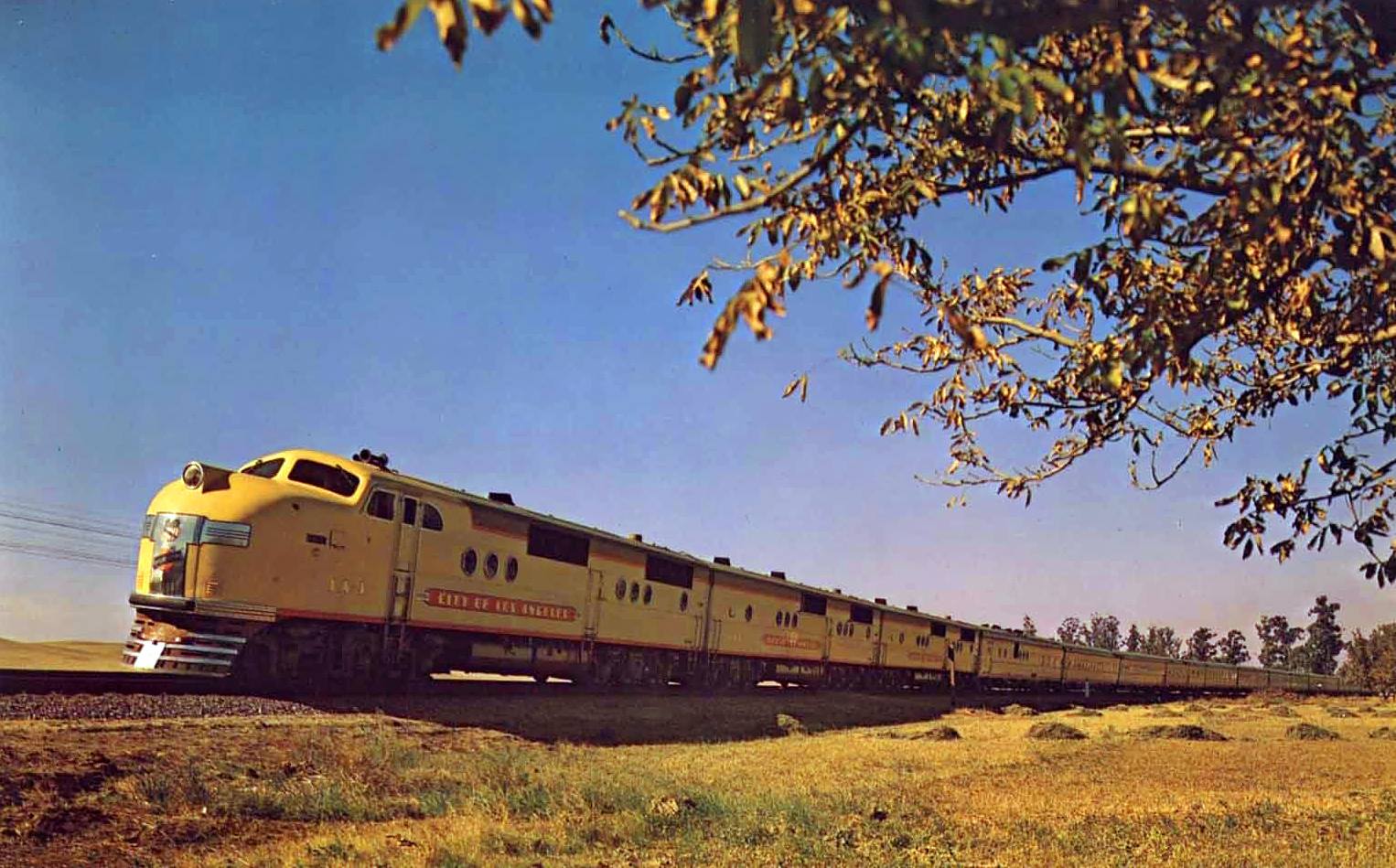 A Union Pacific publicity photo featuring the "City Of Los Angeles," led by E2A "LA-1" with E2B's "LA-2" and "LA-3" trailing, posed somewhere in California circa 1939.
A Union Pacific publicity photo featuring the "City Of Los Angeles," led by E2A "LA-1" with E2B's "LA-2" and "LA-3" trailing, posed somewhere in California circa 1939.Final Years
Ridership was so high at this time the railroad still operated two westbounds (Trains #103 and #107) and eastbounds (Trains #104 and #108) daily. The train at this time typically could make the run in about 40 hours carrying an average train speed of nearly 57 mph.
There was also through sleeper service available on both the Pennsylvania and New York Central railroads to New York City via Chicago. Through the end, the City of Los Angeles continued to maintain an all matching consist.
By the late 1960s the City of L.A. was down to just an eastbound and westbound run - at which time most of its counterparts had been combined into one massive train east of Cheyenne. Union Pacific's services remained high until the end when trains made their final run on April 30/May 1, 1971.
Sources
- Burns, A.J. and Dawson, Leslie. Official Guide Of The Railways And Steam Navigation Lines Of The United States, Porto Rico, Canada, Mexico, and Cuba, The. Volume 85. Issue 3. Pages 839-843. New York: National Railway Publication Company, 1952.
- Johnston, Bob and Welsh, Joe. Art Of The Streamliner, The. New York: Andover Junction Publications, 2001.
- Schafer, Mike and Welsh, Joe. Streamliners, History of a Railroad Icon. St. Paul: MBI Publishing, 2003.
- Solomon, Brian. Streamliners: Locomotives And Trains In The Age Of Speed And Style. Minneapolis: Voyageur Press, 2015.
- Welsh, Joe and Holland, Kevin. Union Pacific Railroad. Minneapolis: Voyageur Press, 2009.
Contents
Recent Articles
-
C&O 2-10-4 Locomotives: Specs, Roster, Photos
Apr 13, 25 04:07 PM
Chesapeake & Ohio's T-1s included a fleet of forty 2-10-4 "Texas Types" that the railroad used in heavy freight service. None were preserved. -
Chesapeake and Ohio Railway: Map, Logo, History
Apr 13, 25 04:07 PM
The Chesapeake and Ohio Railway was a famous southern line that operated from Norfolk to Chicago and through much of Michigan. -
C&O 4-8-4 Locomotives: Specs, Roster, Photos
Apr 12, 25 09:52 PM
Chesapeake & Ohio's fleet of 4-8-4s, listed as Class J-3/a, included twelve examples of 4-8-4s the railroad termed "Greenbriers." Today, #614 survives.
